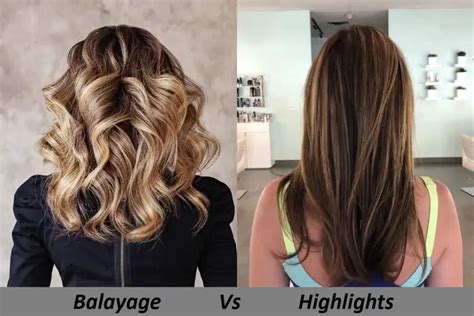Introduction
In the realm of hair coloring techniques, two titans clash for supremacy: highlights and balayage. Both methods promise to enhance your mane, but discerning their subtle differences can elevate your next salon appointment into a transformative experience. Embark with us on a comprehensive journey to unveil the intricacies of these two techniques, empowering you with the knowledge to choose the optimal style that complements your unique features and aesthetic aspirations.

The Anatomy of Highlights
Highlights, also known as foiling, involve meticulously placing thin sections of hair into aluminum foils and applying bleach or color. This technique creates distinct, contrasting streaks that frame the face and add depth and dimension. Highlights often employ a 2-3 level lift in hair color, transitioning your tresses to a lighter shade while maintaining a noticeable contrast with your natural base level.
Advantages:
- Precise Control: Foiling allows for precise placement and even distribution of color, resulting in a controlled and tailored look.
- Versatile Customization: Highlights can be customized to suit any hair type, texture, and length, catering to a wide range of desired effects.
- Emphasis on Framework: Highlights expertly draw attention to your facial features, framing and enhancing your best assets.
Disadvantages:
- High Maintenance: Foiled highlights require regular touch-ups to maintain their vibrant appearance, potentially becoming a time-consuming and costly endeavor.
- Potential Damage: The use of bleach or color during the highlighting process can lead to hair damage if not properly executed or if overused.
- Limited Dimensionality: While highlights add depth, they tend to create a less blended, more stripey effect compared to other techniques.
The Essence of Balayage
Balayage, a French term meaning “to sweep,” is a freehand painting technique that mimics the natural effects of sun-kissed hair. Instead of foils, a brush or paddle is used to apply bleach or color directly to select strands of hair, creating soft, subtle gradients that seamlessly blend into your natural color. Balayage typically involves a 1-2 level lift, ensuring a more natural and lived-in look.
Advantages:
- Naturalistic Effect: Balayage creates a highly blended, sun-kissed look that effortlessly transitions from your natural hair color to the lighter highlights, mimicking the effects of natural sunlight.
- Low Maintenance: Unlike highlights, balayage requires less frequent touch-ups as the regrowth appears less noticeable due to the gradual blending of colors.
- Dimensional Versatility: Balayage offers endless possibilities for creating unique and flattering transitions, enhancing the natural contours and movement of your hair.
Disadvantages:
- Less Control: The freehand nature of balayage can lead to less precise placement of color compared to highlights, potentially resulting in less defined or predictable outcomes.
- Skill-Dependent: Achieving a successful balayage requires a high level of artistry and experience from the stylist to ensure a seamless and natural-looking blend.
- Time-Consuming: Balayage is a more time-intensive technique compared to highlights, requiring patience and a longer salon visit to achieve the desired effect.
Comparing the Titans: A Comprehensive Analysis
To facilitate an informed decision between highlights and balayage, meticulous consideration of their respective attributes and suitability for your individual hair needs is paramount.
Hair Texture:
- Fine Hair: Highlights may be more suitable for fine hair as they can add volume and texture, while balayage could potentially weigh down fine strands.
- Medium Hair: Both highlights and balayage can effectively enhance medium hair, offering versatility in creating a range of looks.
- Thick Hair: Balayage is generally preferred for thick hair as it provides a more natural-looking blend and reduces the risk of brassiness that can occur with highlights on thick tresses.
Face Shape:
- Round Faces: Highlights can help elongate round faces by creating vertical lines that draw attention upward. Balayage, on the other hand, can widen the face, potentially making it less suitable.
- Oval Faces: Both highlights and balayage can flatter oval faces, providing options for customization and enhancing natural features.
- Square Faces: Highlights can soften the angles of square faces, while balayage can add warmth and depth.
The Ultimate Choice: Deciding What’s Right for You
The optimal choice between highlights and balayage hinges upon your unique hair characteristics, desired aesthetic, and lifestyle preferences.
Consider Your Lifestyle:
- Maintenance: If you’re seeking a low-maintenance option, balayage may be your ideal choice due to its less frequent touch-up requirements.
- Time Commitment: Balayage typically requires a longer salon visit compared to highlights; if time is a constraint, highlights may be more practical.
Embrace Your Hair’s Natural Beauty:
- Natural Appeal: Balayage is renowned for its ability to mimic the natural effects of sun-kissed hair, creating a subtle and effortless look.
- Dimensional Enhancement: Highlights provide a more defined and contrasting effect, adding depth and dimension to your hair.
A World of Possibilities: Innovative Techniques
Beyond traditional highlights and balayage, a myriad of innovative techniques have emerged, pushing the boundaries of hair coloring artistry:
- Ombré: A gradual transition from dark roots to light ends, creating a sophisticated and modern look.
- Sombre: A softer version of ombré, blending dark roots into lighter shades more subtly.
- Babylights: Extremely fine highlights placed close to the roots, providing a natural, sun-kissed effect.
- Microblading: A technique that uses tiny blades to create hair-like strokes, mimicking the appearance of natural eyebrows on the scalp, filling in sparse areas or creating a fuller look.
Conclusion
The realm of hair coloring is a vast and captivating canvas, with highlights and balayage as two of its most celebrated techniques. Embracing their distinct advantages and understanding their suitability for your hair type and lifestyle will empower you to make an informed decision and achieve the mane of your dreams. Whether you desire a subtle sun-kissed glow or a more dramatic transformation, there’s a technique waiting to unlock your hair’s full potential. Dare to experiment, consult with your trusted stylist, and embark on a journey of hair transformation that will leave you radiant and confident.
